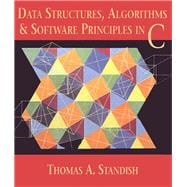Using C, this book develops the concepts and theory of data structures and algorithm analysis in a gradual, step-by-step manner, proceeding from concrete examples to abstract principles. Standish covers a wide range of both traditional and contemporary software engineering topics. The text also includes an introduction to object-oriented programming using C++. By introducing recurring themes such as levels of abstraction, recursion, efficiency, representation and trade-offs, the author unifies the material throughout. Mathematical foundations can be incorporated at a variety of depths, allowing the appropriate amount of math for each user.









